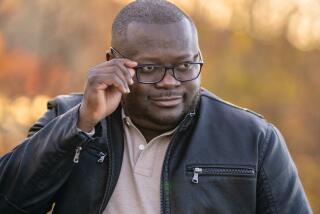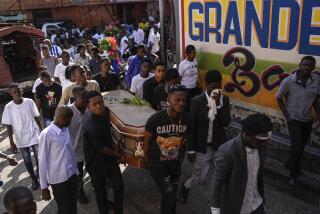Haiti: Sense, Sensibility and Savagery : THE RAINY SEASON Haiti Since Duvalier <i> by Amy Wilentz (Simon & Schuster: $18.95; 372 pp.)</i>
In the town of Gonaives, on the morning of the abortive election of November, 1987, a woman with a child in her arms was among a small group who lined up outside the school where they were to vote. The town had rocked all through the night to the sound of exploding grenades and gunfire. The polling station outside which the people were waiting had no ballot papers. “Why are you here?” Amy Wilentz asked the people. “Because someone has to be willing to die to change Haiti,” the woman replied. “I despise their guns. I spit on their guns. We have had enough of them, too much. . . .”
That day, all over Haiti, many were to die, men, women and children, shot by those guns, hacked by machetes, as they waited in polling stations to vote in an election that some hoped might change Haiti. It did not. Haiti continues in its savage violence, its hunger, its disease and its passions and, like a colored thread running through this dark background, its vibrant humanity.
Wilentz has written a remarkable book. Like many of those who have been part of the group of foreign journalists on the veranda of the Oloffson Hotel, or the dining room of the Holiday Inn, peering literally and figuratively into the night and trying to make sense of its sounds and smells, I have had to grapple with the problem of how to write about a country that seems to obey no familiar rules, where information is an illusion, where the only certainty is that if something nasty happens today, something even worse will happen tomorrow. Reporters tend to travel to Haiti with a mixture of dread and fascination. Dread, because it can be one of the most unpleasant and bemusing places to cover, because it leaves a trace of unerasable and grim memories, a legacy of nightmarish images that return, unbidden, to the mind. Fascination, because, in spite of all that, it is one of those countries that gets under the skin.
The British reporter that Wilentz names as “Harry” is an extreme case of Haiti-fascination, obsessively documenting the daily minutiae of a continuing tragedy. But others are infected too, not because Haiti inspires any hope but because the awful drama of it grips the mind and the emotions as few other places do.
There are one or two classics that are as much a part of the visiting reporter’s luggage as the short-wave radio and the portable computer: Graham Greene, of course, and Bernie Diedrich. Now there is also Wilentz.
All of Haiti’s cast of characters are here. There is a marvelous portrait of Father Aristide, the tiny, frail priest who became the emblem of the popular church and of the people’s hopes for change, a man who somehow survived one murderous assault after another. Finally, he was expelled from his order with the approval of the Vatican after his church was reduced to a smoking ruin in the attack that was to rebound on its perpetrators and bring about the fall of Namphy.
There are the houngans and the healers, with their boxes of tricks and powerful mysticism, who sometimes cure and sometimes kill, but always drain away the money. There are the AIDS victims, some of them infected by the unsterilized needles wielded indiscriminately by the healers. There are the aid workers, who have seen their well-meant but often misdirected efforts become the target of popular rage. There are the more sinister helpers, missionaries who all but enslave their converts and live well on labor reimbursed only with food handouts.
There are the embassy officials, blind to everything but the pursuit of policy goals, whatever it costs. There are the murderers, the men in uniform and the men in dark glasses who kill with savage impunity. And there are their victims, the countless savaged corpses whose death never seems to make any larger point than that terror is what counts. There are also those who are dying a slower death, of hunger and disease and those who, in spite of it all, remain alive in spirit and courage as well as body.
Throughout the book, too, there is the author, a sympathetic presence, involved but not obtrusive, skillfully interweaving history and actuality to create a narrative that has both depth and immediacy. This narrator is unashamedly there but does not seek to impose or to score points off her interlocutors. She is frank about her fears, without glorifying her undoubted courage. When it is too dangerous, she runs, as we all do, for cover, or backs off from insisting on a point.
But when the visiting reporters fly out (mostly, if I remember rightly, with enormous relief), Wilentz is still there, covering the ground, building relationships, filling in the gaps, trying to make her own sense of Haiti. In the end, she, too, gets on the plane home and lives there haunted by the recurring images of Haiti.
“I was at a loss to interpret these images,” she says, “as much at a loss as I had been when I met them face to face. Every time I had turned my head in Haiti, it seemed, I had met another person or seen another thing that was filled with a meaning I could not quite make out . . . the farther I wandered, the more disoriented I became.”
Finally, she realizes that what she has learned is to see things through Haitian eyes in the sense of seeing not Haiti’s exoticism in the images that so overpower the visitor but its normality. It is a modest conclusion at the end of an arduous road courageously traveled.
More to Read
Sign up for Essential California
The most important California stories and recommendations in your inbox every morning.
You may occasionally receive promotional content from the Los Angeles Times.










